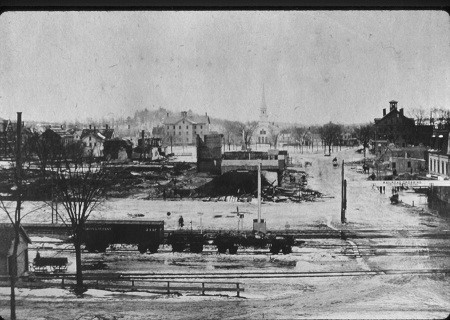
Natick town center almost leveled by fire in 1874.
Two Devastating Fires in Natick
Terrible Visitation!
The heart of our town in ashes.
Clark’s new block, the pride of Natick, in ruins.
Natick will rise again.
Main Street in Natick before the Great Fire of 1874
In mid-January 1874, The Natick Bulletin’s headlines shouted the dreadful story. A fast-moving fire had destroyed 37 buildings and much of the town center. Losses were estimated at over $650,000. On January 14, The Boston Globe said the previous day’s conflagration was “One of seething flame, the light of which illuminated the sky for a distance of twenty miles around!” Newspaper editors and writers didn’t hold anything back in the late 19th century. The stories were hyped with sensational details, and they openly embraced a community spirit that reflected the alarming impact of the fire.
The January 13 early morning blaze leveled most of five business blocks and 18 structures in the center of town, made almost 25 people homeless, burned the First Congregational Church, and melted its bell. Nearly every building was destroyed in the blocks bounded by Central, Main, and Washington streets and the railroad.
For a small town like Natick—the population was about 7,500 in 1874—the loss was comparatively worse than the destruction in the Great Chicago Fire of 1871. As in most towns, the wooden structures made fire a constant danger. The horrible inferno on that cold January night all too vividly brought to mind the destructive blaze that leveled seven buildings in the center of South Natick less than two years earlier. That fire, on March 2, 1872, was a calamity on a smaller scale, but it sometimes gets a footnote in town histories. The South Natick fire burned the Natick Historical Society’s first collection of stuffed animals and artifacts (see story below).
The downtown fire started about 3 a.m. at the southwest corner of Summer and Main streets, close to the fire department’s Eagle Engine House—which burned down. The blaze spread south to engulf most of “Clark’s elegant block” facing Central Street and also moved north across Summer to consume the Wolcott Shoe Factory and much of that block. Capricious winds arched the flames eastward across Main Street. They ignited a couple dozen businesses and dwellings, consuming the First Congregational Church, the fire department’s hook-and-ladder house, banks, shoe factories, dry goods stores, town offices, and two “coffin warerooms.” Within four hours, the terrible destruction was complete. The losses amounted to about 20 percent of all taxable property in the town.
In this view looking south, much of the town center burned to the ground.
The firefighters worked valiantly to control the fire but they were ill-equipped to do so. The town’s steam-powered pump was cranky; getting the boiler started was trouble, and old canvas hoses burst when they were pressurized. It took 20 minutes to start the water flowing. There was an inadequate system of “reservoirs” (scattered ditches, 20-30 feet deep) that served as the emergency water supply. South Natick, Ashland, Framingham, and Newton sent men and equipment to help—like the “hand engine from Saxonville…[that] rendered most efficient and valuable aid”—and Boston firemen brought a steam pump by special train. The horse-drawn apparatus mainly arrived too late to do much good, and the insufficient water supply limited the work. Natick and many neighboring towns upgraded their firefighting capabilities significantly after the fire. Within a year, Natick installed 78 new fire hydrants.
In profoundly sad language, The Natick Bulletin wrote the lead of its first story about the fire: “The business portion of our beautiful town lies in ashes. The fire demon has laid his withering hand upon the home of nearly our mercantile, religious, and professional interests, and it has vanished from sight. It is almost too terrible to realize.”
The Bulletin’s fire coverage devoted a mournful paragraph to the loss of the Congregational Church: “The burning of the spire of the Congregational church was a most magnificent spectacle, though a sad one. The body of the edifice had been consumed and had fallen in, leaving the spire standing like a flame-sheeted spectre. As the covering became burned, it left the frame exposed to view, presenting a complete network of glowing fire…Just before the bell fell from its position, it gave three mournful strokes, as if in solemn farewell.”
Expressing the expansive communal optimism of that era, the Bulletin declared: “The burnt district will be rebuilt with the coming of Spring, and in place of the wooden structures which lately stood will rise brick and stone buildings.” Within a week, the rebuilding had begun.
Natick selectmen got the ball rolling by approving funds for a new firehouse, and a year later, the new Central Fire Station (now converted for use by The Center for Arts in Natick, TCAN) opened on Summer Street. It had four large bays for horse-drawn firefighting equipment, with suspended leather harnesses lowered onto the eager horses when a fire alarm sounded.
The 1872 Fire in South Natick
The horrific fire in downtown Natick on January 13, 1874, was a transformative event in the town’s history. It’s a bit too easy to forget that an earlier fire—on March 2, 1872—caused similar devastation and change in commercial and civic life in South Natick. The South Natick blaze destroyed more than property. The March 4, 1872, edition of the Worcester Evening Gazette reported: “The fire is especially to be mourned from the fact that it has swept away the heart of the ‘old town’ rendered of interest to all, as the seat of Mrs. Stowe’s famous story.”
The Charles River Coffee House and other modern South Natick enterprises now occupy the site of the 1872 blaze. Volunteer firemen did their best, but the early morning fire rapidly consumed the Merchants Block and other buildings along Eliot Street (Route 16), then a dirt road west of the meetinghouse at Eliot and Union streets. Reportedly, it started in the basement of a dry goods/clothing store and spread to seven structures. The Evening Gazette estimated losses at over $65,000 (more than $1.3 million in current dollars). No injuries were reported.
These businesses were wiped out: I. B. Clark’s Dry Goods Store, William Edwards’ Clothing Store, the L. A. Kingsbury meat market, E. Heuber’s barbershop, the Smith & Lewis grocery/drug store, the Goin Bailey Hotel, and the Old Tavern, then called Eliot House, that was operated by Goin Bailey. Two homes burned down. Also, the South Natick Post Office and Engine House (fire department) were severely damaged. An 1880 History of Middlesex County noted: “But the energy of the people rebuilt at once larger and better than before.”
Perhaps the most tragic loss was the collection of the two-year-old Historical and Natural History Society of South Natick and Vicinity—our present-day Natick Historical Society—which occupied an upper floor above the Edwards store in the building where the fire started. At that time, the society’s holdings principally were extensive plant and animal (chiefly birds) specimens gathered by local volunteer collectors and “historical relics treasured in private families for generations,” according to the Evening Gazette. Among the species of flora was the “second best” collection of ferns in the United States.
The young society’s entire collection was valued at $2,500 (current dollars: more than $75,000), and the Gazette said, “The loss falls not upon the society alone but upon every lover of art or student of nature.” An enthusiastic benefactor traveled to South America the following year to replace the scientific collections.
return to 19th-century menu:
click here
Selected sources and additional reading:
Natick Historical Society collections.
The Center for Arts in Natick. “The Historic Firehouse.” Accessed June 22, 2019. http://www.natickarts.org/historic-firehouse
James W. Morley, Natick 1651-2000: The Many Lives of a Storied New England Town, 2019


